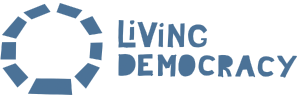3.1 “I would like my students to be able to …”
“After we practised techniques of presentation, I would like all my students to be able to address the class without reading out their notes.”
“After we have spent six lessons on the basics of our constitution, the least I would expect from all my students is that they can explain how our election system works, and what parties are running the government at the moment.”
“A few months ago, we had problems in our class with students who wouldn’t listen to each other in discussions and interrupted students they disagreed with. We have talked a lot about our right of free expression and that this only works for all of us if we treat each other with respect. By the end of the year, I hope most students will have understood this and know how to behave in discussions.”
These examples show the kind of thoughts that an EDC/HRE teacher has in mind when planning lessons: they define objectives. They decide what their students should be able to do, and what is in their reach if they make an effort: they decide what objectives they would like their students to achieve, and then look at the process of learning and the students’ learning needs at the starting point – their difficulties and abilities, their strengths and weaknesses.
This way of thinking is nothing new for teachers – it is a common practice. Most teachers do not only think about the topic and subject matter – “I’ve got to finish the 19th century before the next holiday break” – but also have in mind what kind of performance they want to see from their students.
Objectives that focus on the students and what they should be enabled to do refer to students’ competences. In adult life, all students will have to cope without a teacher, coach or monitor beside them. The traditional teaching model – formal instruction, delivering a tight curriculum of knowledge – does too little to support students to become independent, confident and competent across the dimensions of skills and values/attitudes.
The three examples also point to different dimensions of competence development:
- The first – establishing eye contact with the audience and speaking freely – refers to skills that are not content-specific, but provide the tools that students permanently need to make use of any piece of knowledge and information. This is skills training, or teaching “for” democratic citizenship and human rights – to enable students to exercise their human rights and take part in democracy.
- The second – understanding the basics of the election system and who has won the last election and therefore formed the present government – is a case of teaching “about” democracy and human rights. Young citizens must know what human rights – for example, taking part in elections – have been integrated as a civil right in their country’s constitution and what effect their vote has in their country’s election system.
- Finally, the last example shows the importance of values and attitudes. Democracy relies on a political culture that is formed by the attitudes and values that citizens adhere to, in this case mutual respect and tolerance for views that they may disagree with. Students must be willing to accept that their right of liberty must take into account the rights of others. Therefore freedom carries responsibilities. A human rights culture reflects both the empowerment of individual learners and their teachers but also an understanding that we share mutual respon-sibility to respect the human rights of others. Values are learnt though experience and convincing role models – teaching “through” democracy and human rights.
3.2 Competences – a general definition
Competences refer to what a person is able to do, in three respects that form the core of a person’s identity:
- what a person knows and has understood;
- the skills enabling a person to use her or his knowledge;
- the awareness and appreciation of the knowledge and skills that a person possesses, resulting in the willingness to use them both with self-confidence and responsibility.
The last point is of particular importance. Not only should the teacher know what the students have been enabled to do, but even more so the students themselves. They must know what they have in their mental toolbox and what tasks or problems those tools can be applied to. Above all, they need self-confidence to accept the risk of failure in their processes of lifelong learning.
3.3 How can teachers find out what competences students have? Competence and performance
Competences refer to abilities and potentials “inside” us. They are therefore invisible. Then how can teachers find out what competences their students have?
Here is an example. Noam Chomsky, a linguist, described the language competence of a native speaker. Native speakers permanently create and understand sentences that they have never spoken or heard before. We cannot see the language competence, but we perceive the native speaker’s performance, and we must assume that the competence to communicate fluently must be there.
There is no competence without any visible performance, but also no kind of action without competences. Teachers assess their students’ competence development by judging their performance – what they are capable of doing. Task-based learning enables students to train their competences, and teachers to assess their students’ learning achievements and identify their learning needs. This applies not only to EDC/HRE, but to teaching and learning in general.
3.4 A model of student competences in EDC/HRE
We assess a student’s competence development through our perception of the student’s performance. Competences are invisible, and we can only gain access to them by designing models that support us in defining learning objectives and guiding our assessment of learning achievements.
In this EDC/HRE edition, we have adopted the following model of competences. It corresponds to the key principles of EDC/HRE – teaching through, about and for democracy and human rights.
In EDC/HRE, student competences include the following:
- political analysis and judgment;
- skills (See Part 3 of this volume);
- taking action and political participation;
- personal and social competences.
3.4.1 Competences of political analysis and judgment
Democratic citizenship requires citizens to understand the issues under discussion, which requires citizens to be informed and capable of analysing problems and lines of argument and conflict. This is the cognitive dimension of competence development (learning “about” political issues).
Without this level of understanding a citizen is easy prey for demagogues, lobbyists and populists, and will not be able to identify and negotiate his or her individual or group interests. We depend on media as sources of information, and we must be able to use them critically.
Taking action in politics, as elsewhere in life, is only possible if we know what we want to achieve. We must be able to define our interests and objectives, balancing wants and needs, values and responsibilities. Politics is a process of decision making to solve problems and settle conflicts; there is no option not to make a decision, and decisions are not possible without judgment.
Increasing complexity in our modernising societies tends to overstrain the “normal citizen’s” competences of analysis and judgment. Personalising – trust or distrust towards political leaders – is one way of reducing complexity. Education, not only in EDC/HRE, is the key to enable citizens to keep abreast of the decisions that affect them.
3.4.2 Skills
Students need a set of mental tools – skills or techniques – to acquire and use information and to form their opinions independently and systematically. These tools enable students:
- to acquire information both through media and first-hand experience and research – techniques of using print and electronic media, interviews, research, reflection, etc.;
- to select and study information (constructivist learning) – techniques of planning, time management, reading, thinking, recording;
- to determine, present, share, and argue their views – techniques of creating handouts, posters, papers, PowerPoint presentations, lecturing, discussing, debating, etc. (joint constructivist learning and deconstruction);
- to reflect the outcomes and processes of learning and application.
To a considerable extent, these skills are necessary not only in EDC/HRE, but in school as a whole. They prepare students for more advanced academic studies and for qualified jobs. Cross-curricular training of these formal, content-unspecific skills is therefore both necessary and possible.
3.4.3 Taking action
In EDC/HRE, formal skills training supports learning for democracy and human rights, but is not sufficient. EDC/HRE conceives school as a micro-community in which the students learn how to take part in society and politics by practical experience. The competences they train in school include the following:
- reflecting their wants and needs, clarifying and promoting their interests;
- voting, taking part in elections as voters and candidates (class representatives);
- negotiating and decision making;
- influencing decision-making processes through awareness raising, lobbying and collective action;
- understanding and appreciating the need for a framework of rules and sanctions.
EDC/HRE, and school as a whole, play a decisive part in providing the learning opportunities for students to contribute to their communities. However, in assessing their performance and competence development, school has its limits. The decisive area of transfer lies beyond school, in society as a whole, and extends into adult life. It then becomes difficult, if not impossible, to link learning outcomes to inputs in school.
3.4.4 Personal and social competences
Perhaps the concept of competences is somewhat overstrained when it is extended to the dimension of values and attitudes. On the other hand, it is the performance, the way students behave, that counts, and the disposition to behave can be conceived as competence. This dimension of competence development corresponds to learning “through” democracy and human rights. It includes the following:
- self-awareness and self-esteem;
- empathy;
- mutual respect;
- appreciation of the need to compromise;
- responsibility;
- appreciation of human rights as a collectively shared set of values to support peace, justice and social cohesion.
3.5 Teacher competences in EDC/HRE
In EDC/HRE, teachers require specific competences to offer their students adequate learning opportunities.
The toolbox for teachers includes a tool to support teachers in defining competence-based objectives in EDC/HRE, very much along the lines that the introduction to this unit referred to. For further information, please refer to the Council of Europe publication How all teachers can support citizenship and human rights education: a framework for the development of competences (Strasbourg, 2009).


 You are reading Volume I
You are reading Volume I 
